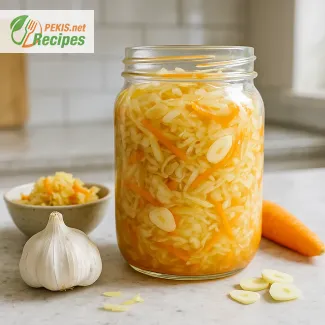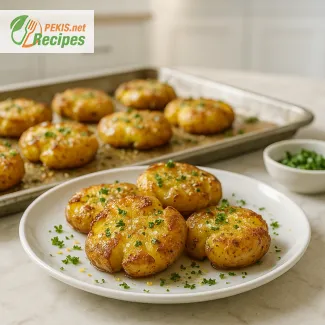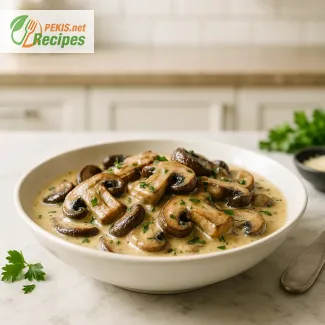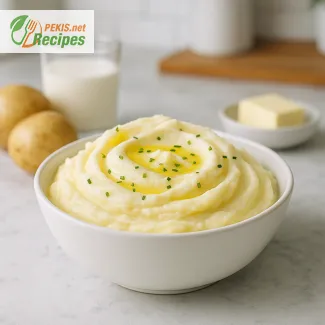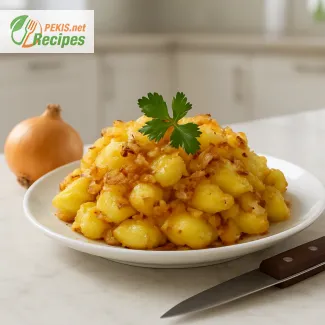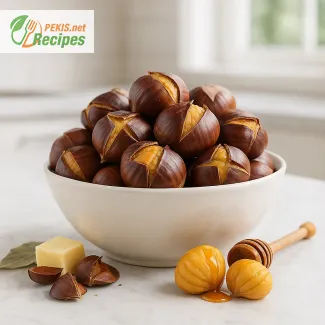Rich and golden potato gratin delivers pure comfort in every bite — a layered dish of thinly sliced potatoes, cream, garlic, and melted cheese baked to perfection. Ready in about 80 minutes (20 prep / 60 cook), it serves 6 portions of creamy, flavorful goodness with a crisp top and tender interior. Ideal as a side for roasts or festive dinners, it stays delicious even when reheated the next day. The gratin can be prepared in advance, stored in the fridge, and baked before serving for that perfect golden, bubbling crust.
Years of perfecting comfort food have shown that small details make a big difference — the exact potato thickness, the balance between cream and cheese, the patience to let flavors settle. Every time this potato gratin comes out of the oven, the kitchen fills with that familiar aroma of home and warmth. It’s the kind of dish that connects tradition with creativity, where simple ingredients transform into something deeply satisfying.
PEKIS – a professional chef and recipe developer with over 25 years of experience in cooking and baking, specialized in European and international cuisine.
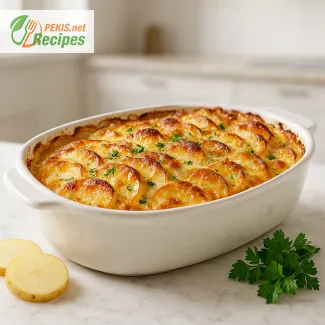
Creamy Layers of Comfort – A Perfectly Baked Potato Gratin
Golden, tender potatoes with a velvety cream and cheese finish
Few dishes capture pure comfort like a beautifully baked potato gratin. Thin slices of potatoes slowly cooked in cream, garlic, and melted cheese create an irresistibly golden crust and melt-in-your-mouth texture underneath. Every forkful brings together rich creaminess, gentle seasoning, and the natural sweetness of perfectly cooked potatoes. It’s the kind of side dish that quietly steals the spotlight from whatever it accompanies — whether a Sunday roast, a festive dinner, or a simple family lunch.
The secret lies in balancing the starch and cream, letting the potatoes release just enough natural thickener to turn the sauce into a silky coating. When done right, the layers stay defined, tender but never mushy, and the top forms that crisp, bubbling crust everyone fights over.
A classic with deep roots in French tradition
Originating from rural France, gratin dauphinois has been loved since the 18th century for its simple ingredients and refined texture. Farmers used readily available potatoes, milk, and butter — later elevated with cream and cheese as the recipe reached urban kitchens. In modern cuisine, it’s often called simply potato gratin or au gratin potatoes, but its essence remains unchanged: transforming humble ingredients into something truly elegant. Today, it’s a staple across Europe and North America, appearing in both fine dining and home-cooked family meals.
Why you’ll love this potato gratin
- Golden and crispy on top, creamy and tender inside
- Perfect side dish for meats, roasts, or festive gatherings
- Make-ahead friendly and easy to reheat
- Comforting flavors with just a few simple ingredients
- Customizable with herbs, cheeses, or vegetables
- Feels luxurious but uses everyday staples
The texture that defines perfection
Each bite should offer a balance between soft, buttery potatoes and a crispy gratinated crust. Achieving that harmony means slicing potatoes thinly and evenly — usually about 2–3 mm thick. Thinner slices absorb the cream more evenly, creating delicate layers that hold together when served. Using a mandoline ensures precision, while starchy potatoes (such as Russet or Yukon Gold) provide the best texture.
As the gratin bakes, starch from the potatoes blends into the cream, forming a natural thick sauce. The top layer, exposed to heat, turns beautifully golden and crisp, while the inner layers stay tender and infused with garlic-scented cream. That contrast of textures is what sets a great gratin apart.
Flavor balance and ingredient synergy
The flavor of potato gratin depends on the interplay between cream, garlic, and cheese. Garlic infuses the sauce with warmth, while nutmeg or thyme adds subtle depth. A mix of hard and soft cheeses — such as Gruyère, Comté, or Parmesan — delivers both flavor and the perfect melt. The cream should be rich but not overpowering; it carries the flavor through every layer without becoming heavy.
For an even silkier result, some cooks combine milk and cream, ensuring the mixture stays light while still indulgent. Salt should be added carefully: since cheese contributes saltiness, a light hand keeps the dish balanced. The final sprinkle of cheese on top helps form that signature golden crust — the hallmark of any well-made gratin.
Creative variations worth trying
Once you’ve mastered the classic base, you can personalize it with small tweaks that make a big difference:
- Add caramelized onions for a sweet, savory layer.
- Swap part of the cream for chicken stock for a lighter version.
- Incorporate smoked cheese or bacon bits for a rustic twist.
- Layer in thinly sliced sweet potatoes or parsnips for color contrast.
- Sprinkle fresh thyme or rosemary before baking for aromatic depth.
Each variation adds its own charm while preserving the comforting soul of the dish.
Serving ideas and pairings
Potato gratin pairs beautifully with roast chicken, beef tenderloin, baked salmon, or grilled vegetables. Its creamy base complements bold sauces and savory main courses without competing for attention. For festive occasions, it’s an elegant alternative to mashed potatoes, adding visual appeal with its golden crust and layered presentation.
When serving, allow the gratin to rest for about 10–15 minutes after baking. This helps the sauce set, making it easier to cut neat portions. Serve warm, ideally from a shallow ceramic dish that retains heat and highlights the golden top.
Storage and make-ahead tips
Potato gratin can be prepared ahead and stored in several ways:
- Refrigerate the baked gratin for up to 3 days, covered tightly. Reheat gently in the oven to preserve the crust.
- Prepare in advance by assembling the raw layers, covering them well, and refrigerating for up to 24 hours before baking.
- Freeze portions after cooling completely; reheat straight from frozen at a moderate temperature until hot throughout.
These methods make it perfect for holiday planning or busy weeknights when you want a home-cooked side without extra effort.
Culinary context: The essence of gratin in European cooking
The word gratin comes from the French verb gratter, meaning “to scrape” — originally referring to the crispy bits scraped from the bottom of the pan. Over time, it came to define any dish baked with a browned crust, often achieved with cheese or breadcrumbs. Potato gratin stands as one of the most beloved versions, uniting technique, texture, and tradition in one simple casserole.
Across Europe, variations exist:
- In France, gratin dauphinois is traditionally made without cheese, relying solely on cream.
- In Switzerland and Germany, cheese-rich versions are popular, often using Emmental or Appenzeller.
- In Scandinavia, cream-baked potatoes appear on Christmas tables alongside cured fish or roasted meats.
This cultural diversity shows how adaptable the dish is — a true reflection of how simple ingredients transcend borders.
Perfect results every time
For consistent success, remember these key points:
- Use high-starch potatoes to ensure creamy layers.
- Slice evenly for even cooking.
- Do not overbake — the potatoes should stay tender, not dry.
- Let the dish rest before serving for clean slices.
- Choose quality cream and cheese — they define both flavor and texture.
These small details turn a basic gratin into a masterpiece that feels both homely and refined.
Enticing creative twists for modern kitchens
Today’s cooks love reinventing classics, and potato gratin adapts beautifully to creative updates:
- Replace cream with plant-based alternatives for a dairy-free option.
- Add truffle oil or black peppercorns for gourmet flair.
- Top with crispy breadcrumbs for extra crunch.
- Infuse the cream with roasted garlic or shallots before layering.
- Add a touch of smoked paprika for a subtle color and aroma.
These ideas maintain the integrity of the traditional dish while keeping it exciting and versatile for modern dining.
The comfort that never fades
There’s something timeless about golden baked potatoes bubbling gently in creamy sauce. Potato gratin bridges simplicity and sophistication — the perfect harmony between homey comfort and culinary elegance. Whether it’s part of a cozy family meal or a centerpiece on a festive table, its aroma alone evokes warmth, nostalgia, and satisfaction.
Every country gives it a slightly different accent, but the heart of the dish remains the same: layers of tender potatoes, luscious cream, and a crust that invites you to take just one more bite. It’s food that speaks of care, patience, and the joy of sharing — a recipe that deserves its place among the most cherished classics of European cuisine.
- Preheat the oven to 180 °C (356 °F). Grease a medium baking dish with a thin layer of butter.
- Prepare the potatoes: peel and slice them evenly into thin rounds, about 2–3 mm thick (0.1 inch). A mandoline slicer ensures even cooking.
- Make the cream mixture: in a saucepan, heat the cream, milk, garlic, salt, pepper, thyme, and nutmeg. Do not boil—just warm until aromatic, then remove from heat.
- Layer the gratin: place one layer of potatoes in the baking dish, pour a small amount of the cream mixture over them, and sprinkle Gruyère cheese. Repeat the process until all ingredients are used, finishing with cream and cheese on top.
- Add the finishing touch: sprinkle Parmesan and breadcrumbs on the final layer to form a crisp crust.
- Bake: cover the dish loosely with foil and bake for 45 minutes. Remove foil and continue baking for another 15 minutes, until the surface is golden and bubbling.
- Rest before serving: let the gratin rest for 10 minutes before slicing. Garnish with chopped parsley and serve warm.
FAQ questionHow do I keep the potatoes from curdling the cream?
Potatoes release starch, which actually helps the cream thicken, but sudden high heat can cause dairy to split. To prevent this, gently heat the cream and milk first with garlic and seasoning, then pour it over the sliced potatoes. Bake at a moderate temperature (around 180 °C / 356 °F) and avoid boiling. Using full-fat cream also stabilizes the sauce and gives the gratin that silky texture.
FAQ questionCan I make potato gratin ahead of time?
Yes. You can assemble the gratin a day in advance, cover it tightly, and refrigerate it unbaked. When ready, bake it straight from the fridge, adding a few extra minutes. You can also fully bake it, cool it, and reheat it later; just cover it with foil so the top doesn’t burn, then uncover at the end to re-crisp the golden layer. This makes it ideal for holidays and bigger family meals.
FAQ questionWhich potatoes are best for potato gratin?
For the creamiest result, use starchy or medium-starch potatoes such as Russet or Yukon Gold. They release enough starch to thicken the cream and stay tender without falling apart. Waxy potatoes (like red or new potatoes) can be used, but the texture will be firmer and the layers may not meld as nicely. Even slicing (2–3 mm / 0.1 inch) is more important than the exact variety.
FAQ questionDo I have to use cheese in the gratin?
No — traditional French gratin dauphinois is made without cheese and relies only on cream, garlic, and nutmeg. However, adding cheese like Gruyère, Comté, or Parmesan gives the dish a deeper, savory flavor and creates that signature browned crust most people expect. If skipping cheese, make sure the cream mixture is well seasoned so the dish doesn’t taste flat.
FAQ questionWhy is my gratin watery?
A watery gratin usually means too much liquid or not enough baking time. Make sure the potatoes are sliced thinly so they cook through and release starch, and don’t reduce the baking time — it needs long, gentle cooking for the sauce to bind. Also avoid using low-fat milk alone; the dish needs cream or a cream–milk mix to set properly. Resting the gratin for 10 minutes before serving helps the sauce stabilize.
FAQ questionCan I add other ingredients like onions, bacon, or herbs?
Absolutely. Potato gratin is very forgiving and customizable. Thinly sliced onions layered between potatoes add sweetness, crisp bacon adds smokiness, and fresh thyme or rosemary brings aroma. Just don’t overload it — the star should still be the creamy potato layers. If adding watery vegetables, cook or caramelize them first so they don’t dilute the sauce.
Creamy, golden, and irresistibly smooth, potato gratin brings comfort to every table. The combination of tender potato layers, rich cream, and melted cheese creates harmony between flavor and texture that never disappoints. Each bite delivers the perfect contrast between the crisp, caramelized top and the soft, velvety interior beneath it.
A well-made gratin celebrates the beauty of simple ingredients done right. Whether served next to roasted meat, baked fish, or on its own with a fresh salad, it transforms any meal into something memorable. The aroma of baked garlic and thyme fills the kitchen with warmth, while the golden crust signals that comfort is only a few minutes away.
What makes this dish timeless is its versatility — it can be made ahead, adjusted for different diets, or elevated with creative touches like caramelized onions or truffle oil. It fits just as easily into a weekday dinner as it does on a festive holiday table. The flavor deepens as it rests, making leftovers even more indulgent the next day.
Every layer of this gratin tells a story of patience, tradition, and balance. It’s a dish that speaks of care and craftsmanship, where every detail matters — from the even slicing of the potatoes to the golden finish of the crust. Serve it warm, share it generously, and enjoy the comforting pleasure that only homemade potato gratin can bring.
- Milk: Contains cream, butter, cheese. Replace with lactose-free cream and plant-based cheese alternatives for dairy-sensitive diets.
- Gluten: May be present if breadcrumbs are used. Use gluten-free breadcrumbs or omit entirely.
- Possible traces of nuts (depending on cheese origin): choose nut-free certified cheese brands.
Allergen-free alternatives:
- Replace dairy products with oat or soy cream and vegan cheese.
- Omit breadcrumbs or use gluten-free alternatives.
- For a lighter version, replace part of the cream with vegetable stock.
- Vitamin B6: 0.4 mg – supports energy metabolism and brain health.
- Vitamin C: 12 mg – aids immune function and collagen production.
- Vitamin A: 180 µg – essential for eye health and skin renewal.
- Calcium: 240 mg – contributes to strong bones and teeth.
- Potassium: 920 mg – helps regulate blood pressure and fluid balance.
- Magnesium: 40 mg – supports muscle and nerve function.
- Iron: 0.8 mg – assists in oxygen transport in the blood.
- Phosphorus: 210 mg – vital for cell repair and energy release.
- Beta-carotene: 0.2 mg – protects cells from oxidative stress.
- Polyphenols: 40 mg – may support cardiovascular health.
- Selenium: 6 µg – aids antioxidant enzymes and immune defense.
- Vitamin E: 1.4 mg – helps protect cell membranes from damage.
- Glutathione (trace amount): contributes to detoxification and antioxidant regeneration.
